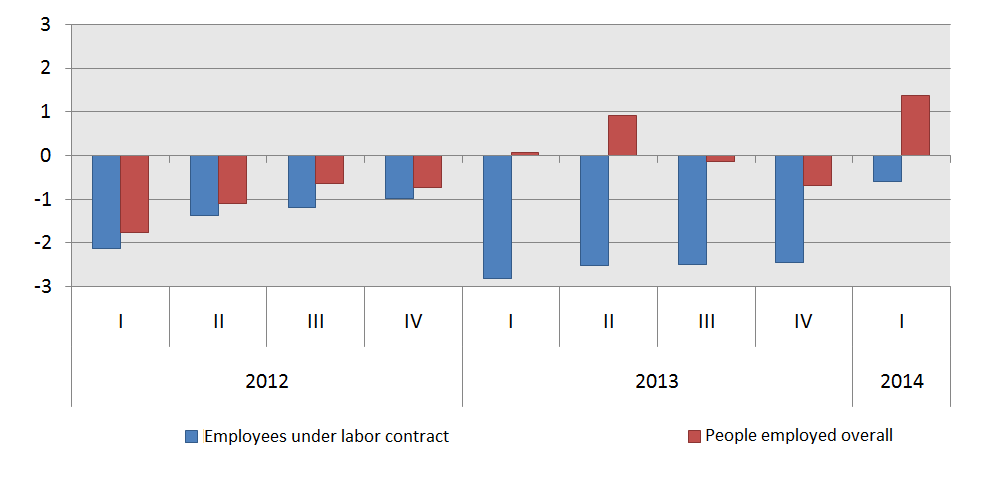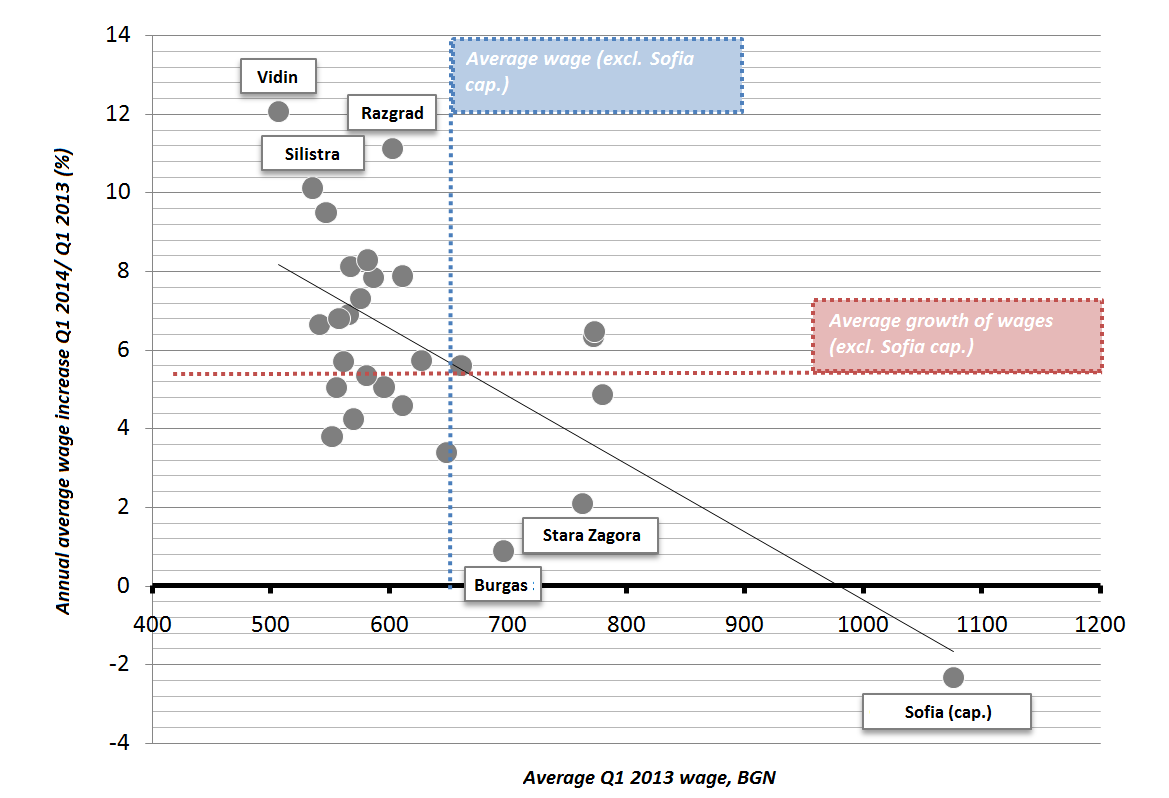Fast Growth of Wages in Some Districts Leads to Drops in the Number of Employees
Despite the recently published positive labor market data, the number of employees under labor contract decreased on an annual basis in each of the first three months of 2014. The decline is concentrated mostly in the poorest areas of the country and is accompanied by a rise in the level of wages - a trend that deserves further attention.
Yavor Aleksiev
According to NSI’s last quarterly labor force survey the number of people employed in the first quarter of 2014 are 39 thousand more than the same period of last year. At the same time, the number of employees under labor contract in the country continues to decline in each of the first three months of the year (yoy), dropping to 2,216 million at the end of March 2014, compared to 2,231 million in March 2013.
The discrepancy of the two indicators is due to the different scope of the data presented in the labor force survey and the short term statistics on the number of people employed under labor contract and their average wages. NSI’s quarterly labor force survey includes all employed, i.e. it is based on survey among a sample of the entire population. Meanwhile, the short term statistics on the number of people employed under labor contract and their average wages are based on a sample of enterprises in both the private and the public sector. These include employees with existing labor contracts, but do not cover the so-called self-employed, or people working under civil contracts and others.
Therefore, the number of employees under labor contract is always smaller than the number of employed in the economy as a whole. Despite that, there has also been some improvement in the dynamics of first quarter data on employees under labor contract. The number of employees under labor contract in the first quarter fell by only 0.6% on an annual basis, which is the most positive result in years.
Figure 1: Annual dynamics of the number of employees under labor contract, %

Source: NSI
In the first quarter of 2014 there is a significant negative correlation (-0.58) between the annual growth in the average wages of employees under labor contract at the district level and the initial levels of those wages in the first quarter of 2013. This means that wages in districts where remuneration is usually higher have been increasing more slowly than wages in areas where they are traditionally lower. This is a somewhat expected result of the minimum wage increase at the beginning of 2014, In the poorer districts where wages are lower, increasing the minimum payments puts upward pressure on average wage levels, thus increasing the average wage. The available data on the number of employees under labor contract and their wages enable us to make some further observations.
Sofia (capital) is the only district in which the wages[1] of employees under labor contract decrease on an annual basis in the first quarter of the year (Figure 2). Other districts with traditionally high wages, but a relatively low increase are Burgas and Stara Zagora. This means that in three of the districts with the highest wage levels in the country, the annual increase in average pay is below the national average of 2.3%. At the same time, some of the largest wage increases are registered in some of the poorest districts. These are Vidin (12.1 %), Razgrad (11.1 %) and Silistra (10.1 %). In each of these three districts, however, the number of employees under labor contract continued to decline. The parallel growth of average pay and the declining number employees could mean that the latest minimum wage increase has forced employers to continue releasing some of their low-paid workers. Statistically, this has the effect of driving average wages in the enterprises concerned higher, which in turn raises average wage levels in respective districts.
Figure 2: Average wage in the first quarter of 2013 and increase registered in the first quarter of 2014 by districts
Source: NSI, IME calculations
In 10 of the 14 districts in which the increase in the average wage of employees under labor contract is higher than the national average (if we exclude the effect of the capital), and wage levels are lower than the national average, there have been three consecutive months of decline in the number of employees on an annual basis. Among them are three of the Northwest region districts - Vidin, Lovech and Montana, where in March the number of people employed under labor contract is 5% lower than the same period last year. Similar developments in terms of the number of employees can also be seen in other relatively less developed districts in the country like Silistra and Razgrad .
Targovishte, Yambol, Smolyan and Veliko Tarnovo are the four districts in which the increase in wages at a rate faster than the national average is not accompanied by a decline in the number of employees.
Meanwhile the labor market has performed relatively well in districts with traditionally higher wages, where the annual increase of remuneration is lower or in line with the national average (excluding the effect of the capital). Most such places observed timid growth or minimal decrease of the number of employees. Such is the case in Sofia district), Plovdiv and Varna.
It is likely that the data reflect a shrinking shadow economy in large districts, a process which puts a downward pressure the level of average wages. A possible explanation of this process can be found in the recently introduced tax incentives for low-income people (the possibility for those receiving minimum wages to request a refund of their income tax for 2014 in the spring of 2015). At the same time, we see no increases in the number of employees in the vast majority of poor districts (on the contrary), despite rising wages. We can speculate that employees there are being released, or that they move into the informal economy. Forthcoming labor survey data on employment at the district level, will allow further examination of this issue.
This is the first time since the beginning of the crisis, when such a significant negative correlation exists between these two factors – rising wage levels and their proportional effect on remuneration in districts where labor is not as well paid. This may be a sign of hitting the ceiling of business’ capabilities to pay a higher minimum wage in some districts. Although data on the labor force survey gives some hope that the negative effect of an increasing minimum wage has been relatively relatively well contained, any subsequent increase should be subject to careful analysis of labor market developments smaller districts.
[1] If we take Sofia (capital) out of the calculations, the average salary in the first quarter 2013 was not 778 BGN, but 641 BGN. Accordingly, the average annual increase in the first quarter of 2014 is not 2 3%, but 5.4%.


